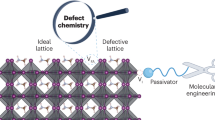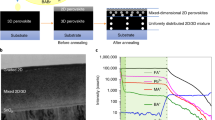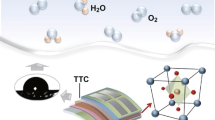Abstract
The surfaces of perovskite solar cells (PSCs) are significant in determining the devices’ efficiencies and stabilities. Here, we first uncover that the 4-tert-butylpyridine (tBP), as an essential additive in hole transport layers (HTLs), could recrystallize the amorphous and defective perovskite surface layers and passivate the defective sites on grain surfaces. The reconstruction induces a larger surface work function and mitigates the interface energy level misalignment between perovskite and HTLs, enlarging the photovoltage of the device. Then, we engineer the chemical bonding strength and develop a more effective HTL additive 4-tert-butylpiperidine (tBPp), which possesses a stronger interaction with perovskite surface defective sites than tBP. With the enhanced adsorption, the tBPp-reconstructed perovskite surface exhibits lower densities of defects and better stability under the stimuli of heat, light and humidity. As a result, the optimized tBPp PSC reaches a champion efficiency of 24.2% with much better operation stability. Tracked at the maximum power point under a continuous bias, the unsealed devices in a N2 atmosphere can nearly maintain their initial efficiency after continuous light exposure for over 1200 h. Our findings provide an underlying understanding of the HTL additives, which markedly affect the efficiency and stability of n-i-p PSCs.

摘要
钙钛矿太阳能电池的表界面性质是影响器件效率和稳定性的关键因素. 本文中, 我们首次发现空穴传输层中的添加剂4-叔丁基吡啶(tBP)可将钙钛矿非晶态和缺陷表面层进行重结晶, 并且钝化晶粒表面的缺陷位. 该重构可使钙钛矿的表面功函数增大, 降低了钙钛矿与空穴传输层之间界面能级失配, 提高了器件的光电压. 进一步地, 我们通过化学键合强度计, 开发了更有效的空穴传输层添加剂4-叔丁基哌啶(tBPp), 它比tBP具有钙钛矿表面缺陷位点更强的相互作用. 得益于吸附能的增强, 经tBPp重构钙钛矿表面缺陷态密度降低, 且在热、光、湿度的作用下稳定性更好. 基tBPp作为添加剂的钙钛矿电池最高效率达到了24.2%. 在氮气气氛中进最大功率点跟踪测试, 未封装的设备在连续光照超过1200小时后几乎可以保持其初始效率. 本工作全面揭示了空穴传输层中添加剂对于钙钛矿池的效率和稳定性的重要性, 并提供了系统和基础性理解.
Similar content being viewed by others
References
Lee MM, Teuscher J, Miyasaka T, et al. Efficient hybrid solar cells based on meso-superstructured organometal halide perovskites. Science, 2012, 338: 643–647
Kim HS, Lee CR, Im JH, et al. Lead iodide perovskite sensitized all-solid-state submicron thin film mesoscopic solar cell with efficiency exceeding 9%. Sci Rep, 2012, 2: 591
Jeong M, Choi IW, Go EM, et al. Stable perovskite solar cells with efficiency exceeding 24.8% and 0.3-V voltage loss. Science, 2020, 369: 1615–1620
Yoo JJ, Seo G, Chua MR, et al. Efficient perovskite solar cells via improved carrier management. Nature, 2021, 590: 587–593
Min H, Lee DY, Kim J, et al. Perovskite solar cells with atomically coherent interlayers on SnO2 electrodes. Nature, 2021, 598: 444–450
Hui W, Chao L, Lu H, et al. Stabilizing black-phase formamidinium perovskite formation at room temperature and high humidity. Science, 2021, 371: 1359–1364
Li N, Niu X, Li L, et al. Liquid medium annealing for fabricating durable perovskite solar cells with improved reproducibility. Science, 2021, 373: 561–567
Kim M, Jeong J, Lu H, et al. Conformal quantum dot-SnO2 layers as electron transporters for efficient perovskite solar cells. Science, 2022, 375: 302–306
Habisreutinger SN, Noel NK, Snaith HJ, et al. Investigating the role of 4-tert butylpyridine in perovskite solar cells. Adv Energy Mater, 2017, 7: 1601079
Wang S, Huang Z, Wang X, et al. Unveiling the role of tBP-LiTFSI complexes in perovskite solar cells. J Am Chem Soc, 2018, 140: 16720–16730
Juarez-Perez EJ, Leyden MR, Wang S, et al. Role of the dopants on the morphological and transport properties of spiro-MeOTAD hole transport layer. Chem Mater, 2016, 28: 5702–5709
Wang S, Sina M, Parikh P, et al. Role of 4-tert-butylpyridine as a hole transport layer morphological controller in perovskite solar cells. Nano Lett, 2016, 16: 5594–5600
Namatame M, Yabusaki M, Watanabe T, et al. Direct observation of dramatically enhanced hole formation in a perovskite-solar-cell material spiro-OMeTAD by Li-TFSI doping. Appl Phys Lett, 2017, 110: 123904
Lamberti F, Gatti T, Cescon E, et al. Evidence of spiro-OMeTAD de-doping by tert-butylpyridine additive in hole-transporting layers for perovskite solar cells. Chem, 2019, 5: 1806–1817
Yue Y, Salim NT, Wu Y, et al. Enhanced stability of perovskite solar cells through corrosion-free pyridine derivatives in hole-transporting materials. Adv Mater, 2016, 28: 10738–10743
Zhang J, Zhang T, Jiang L, et al. 4-tert-Butylpyridine free hole transport materials for efficient perovskite solar cells: A new strategy to enhance the environmental and thermal stability. ACS Energy Lett, 2018, 3: 1677–1682
Ezike SC, Alabi AB, Ossai AN, et al. Stability-improved perovskite solar cells through 4-tertbutylpyridine surface-passivated perovskite layer fabricated in ambient air. Optical Mater, 2021, 112: 110753
Liu C, Ding W, Zhou X, et al. Efficient and stable perovskite solar cells prepared in ambient air based on surface-modified perovskite layer. J Phys Chem C, 2017, 121: 6546–6553
Wu YH, Shi XQ, Ding XH, et al. Incorporating 4-tert-butylpyridine in an antisolvent: A facile approach to obtain highly efficient and stable perovskite solar cells. ACS Appl Mater Interfaces, 2018, 10: 3602–3608
Shi Y, Wang X, Zhang H, et al. Effects of 4-tert-butylpyridine on perovskite formation and performance of solution-processed perovskite solar cells. J Mater Chem A, 2015, 3: 22191–22198
Zheng X, Chen B, Dai J, et al. Defect passivation in hybrid perovskite solar cells using quaternary ammonium halide anions and cations. Nat Energy, 2017, 2: 17102
Chen S, Liu Y, Xiao X, et al. Identifying the soft nature of defective perovskite surface layer and its removal using a facile mechanical approach. Joule, 2020, 4: 2661–2674
Xie J, Yan K, Zhu H, et al. Identifying the functional groups effect on passivating perovskite solar cells. Sci Bull, 2020, 65: 1726–1734
Wang R, Xue J, Wang KL, et al. Constructive molecular configurations for surface-defect passivation of perovskite photovoltaics. Science, 2019, 366: 1509–1513
Liu Z, Liu F, Duan C, et al. Polymerization stabilized black-phase FAPbI3 perovskite solar cells retain 100% of initial efficiency over 100 days. Chem Eng J, 2021, 419: 129482
Ma Z, Yu R, Xu Z, et al. Crosslinkable and chelatable organic ligand enables interfaces and grains collaborative passivation for efficient and stable perovskite solar cells. Small, 2022, 18: 2201820
Jung EH, Jeon NJ, Park EY, et al. Efficient, stable and scalable perovskite solar cells using poly(3-hexylthiophene). Nature, 2019, 567: 511–515
Yoo JJ, Wieghold S, Sponseller MC, et al. An interface stabilized perovskite solar cell with high stabilized efficiency and low voltage loss. Energy Environ Sci, 2019, 12: 2192–2199
Jang YW, Lee S, Yeom KM, et al. Intact 2D/3D halide junction perovskite solar cells via solid-phase in-plane growth. Nat Energy, 2021, 6: 63–71
Zhao S, Qin M, Wang H, et al. Cascade type-II 2D/3D perovskite heterojunctions for enhanced stability and photovoltaic efficiency. Sol RRL, 2020, 4: 2000282
Zhang J, Bai D, Jin Z, et al. 3D-2D-0D interface profiling for record efficiency all-inorganic CsPbBrI2 perovskite solar cells with superior stability. Adv Energy Mater, 2018, 8: 1703246
Azmi R, Ugur E, Seitkhan A, et al. Damp heat-stable perovskite solar cells with tailored-dimensionality 2D/3D heterojunctions. Science, 2022, 376: 73–77
Abdi-Jalebi M, Andaji-Garmaroudi Z, Cacovich S, et al. Maximizing and stabilizing luminescence from halide perovskites with potassium passivation. Nature, 2018, 555: 497–501
Wu WQ, Rudd PN, Ni Z, et al. Reducing surface halide deficiency for efficient and stable iodide-based perovskite solar cells. J Am Chem Soc, 2020, 142: 3989–3996
Tan S, Huang T, Yavuz I, et al. Stability-limiting heterointerfaces of perovskite photovoltaics. Nature, 2022, 605: 268–273
Li C, Li H, Zhu Z, et al. Perovskite passivation strategies for efficient and stable solar cells. Sol RRL, 2021, 5: 2000579
Back H, Kim G, Kim H, et al. Highly stable inverted methylammonium lead tri-iodide perovskite solar cells achieved by surface re-crystallization. Energy Environ Sci, 2020, 13: 840–847
Kong W, Zhao C, Xing J, et al. Enhancing perovskite solar cell performance through femtosecond laser polishing. Sol RRL, 2020, 4: 2000189
Yadavalli SK, Chen M, Hu M, et al. Electron-beam-induced cracking in organic-inorganic halide perovskite thin films. Scripta Mater, 2020, 187: 88–92
Kaneko R, Kanda H, Shibayama N, et al. Gradient 1D/3D perovskite bilayer using 4-tert-butylpyridinium cation for efficient and stable perovskite solar cells. Sol RRL, 2021, 5: 2000791
Sun K, Hu Z, Shen B, et al. Lewis acid-base interaction-induced porous PbI2 film for efficient planar perovskite solar cells. ACS Appl Energy Mater, 2018, 1: 2114–2122
Dong G, Ha J, Yang Y, et al. 4-tert Butylpyridine induced MAPBI3 film quality enhancement for improving the photovoltaic performance of perovskite solar cells with two-step deposition route. Appl Surf Sci, 2019, 484: 637–645
Zhang H, Cheng J, Li D, et al. Toward all room-temperature, solution-processed, high-performance planar perovskite solar cells: A new scheme of pyridine-promoted perovskite formation. Adv Mater, 2017, 29: 1604695
Lin Y, Bai Y, Fang Y, et al. Enhanced thermal stability in perovskite solar cells by assembling 2D/3D stacking structures. J Phys Chem Lett, 2018, 9: 654–658
Zhao S, Xie J, Cheng G, et al. General nondestructive passivation by 4-fluoroaniline for perovskite solar cells with improved performance and stability. Small, 2018, 14: 1803350
Adinolfi V, Yuan M, Comin R, et al. The in-gap electronic state spectrum of methylammonium lead iodide single-crystal perovskites. Adv Mater, 2016, 28: 3406–3410
Zu F, Amsalem P, Ralaiarisoa M, et al. Surface state density determines the energy level alignment at hybrid perovskite/electron acceptors interfaces. ACS Appl Mater Interfaces, 2017, 9: 41546–41552
Acknowledgements
This work was financially supported by the National Natural Science Foundation of China (22005354 and 62025403), Guangdong Basic and Applied Basic Research Foundation (2019A1515110905), and Shenzhen Fundamental Research Program (JCYJ20200109142425294). This work was in part supported by funds from Guangdong Science and Technology Program (2019ZT08L075 and 2019QN01L118). Also, it was in part supported by the Innovation and Technology Commission of Hong Kong SAR(ITS/390/18).
Author information
Authors and Affiliations
Contributions
Xie J conceived the idea and wrote the manuscript. Yan K, Xu J and Gao P supervised the work and revised the manuscript. Zhao S synthesized and characterized the 1D crystals. Xie J and Zhao S prepared the devices and performed the XRD, SEM, UPS, PL and Mott-Schottky analysis. Chen T and Wen B helped measure the PL and XRD. Xie J and Hang P fabricated and characterized most of the perovskite solar cells. Yin Q, Wei S and Zhu S performed the DFT calculation. Hang P estimated the long-term thermal stability of the devices. Qin M and Lu X carried out the GIWAXS measurement. All authors discussed the results.
Corresponding authors
Additional information
Supplementary information
Supporting data are available in the online version of the paper.
Jiangsheng Xie is an associate professor at the School of Materials, Sun Yat-sen University, China. He got his PhD degree from Zhejiang University in 2017. He joined the Chinese University of Hong Kong and did postdoctoral research at the Department of Electronic Engineering and Department of Physics. In November 2019, he joined Sun Yat-sen University as an associate professor. His research interests include perovskite materials and photovoltaic devices.
Shenghe Zhao received a PhD degree in 2020 from the Chinese University of Hong Kong. Now, he is a postdoc at the Department of Electronic Engineering, the Chinese University of Hong Kong. His research interests mainly focus on perovskite solar cells and perovskite light-emitting diodes.
Keyou Yan received his PhD degree in 2013 from the Hong Kong University of Science and Technology. After three-year postdoctoral research, he joined the Chinese University of Hong Kong as an assistant professor. Since 2018, he has been a full professor at the South China University of Technology. His research interests are new-generation photoelectric materials for energy and environmental application, including perovskite solar cells/light emitting diodes, quantum structure devices and environmental detection.
Jianbin Xu received his BSc and MSc degrees from Nanjing University in 1983 and 1986, respectively, and PhD degree from The University of Konstanz. Afterwards, he joined the Department of Electronic Engineering, the Chinese University of Hong Kong. He has been a professor at the department since the midst of 2002. His research interests include solar energy technology, especially hybrid perovskite solar cells, two-dimensional semiconductor materials and devices, organic solid state electronic semiconductors and the optoelectronic devices.
Pingqi Gao is a professor at the School of Materials, Sun Yat-sen University, China. He received his PhD degree at the Department of Physics, Lanzhou University in 2010. He worked at Nanyang Technological University and Ningbo Institute of Materials Technology & Engineering, Chinese academy of sciences and joined Sun Yat-sen University in 2018. His research focuses on developing new semiconducting materials and processes for solar energy conversion and design transition metal-based catalysts for electrochemical applications.
Conflict of interest
The authors declare that they have no conflict of interest.
Electronic Supplementary Material
Rights and permissions
About this article
Cite this article
Xie, J., Zhao, S., Hang, P. et al. Reconstructing the amorphous and defective surface for efficient and stable perovskite solar cells. Sci. China Mater. 66, 1323–1331 (2023). https://doi.org/10.1007/s40843-022-2266-9
Received:
Accepted:
Published:
Issue Date:
DOI: https://doi.org/10.1007/s40843-022-2266-9




